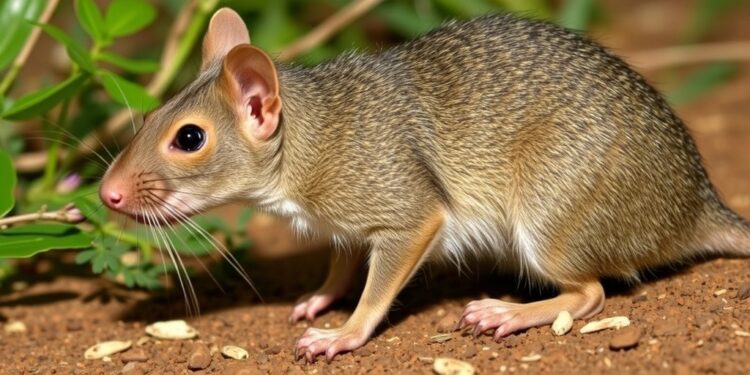
Rat and mouse baits, which serve a crucial role in pest control across homes and workplaces, have come under scrutiny following alarming findings regarding their impact on Australia’s endangered marsupial carnivores. A groundbreaking study conducted by researchers from Edith Cowan University (ECU) has revealed that these commonly used anticoagulant rodenticides, or ARs, pose a significant threat to nine highly vulnerable species, including the iconic Tasmanian Devil and various quoll species. The implications of this research evoke urgent questions about wildlife conservation and pest management practices.
Led by Dr. Michael Lohr, the ECU research team investigated the presence of anticoagulant rodenticides in five of Australia’s largest native marsupial carnivores. The study yielded shocking results: nearly half of the examined animals tested positive for ARs, with some individuals displaying multiple substances in their bloodstreams. These findings raise serious concerns about the extent of the poisoning, potentially leading to long-term ecological repercussions.
More specifically, the research highlighted grim mortality rates among several species. The Tasmanian Devil, a symbol of Australian wildlife, experienced an estimated 15% of tested individuals being exposed to lethal doses of rodenticides, while 10% were subjected to levels likely toxic or potentially lethal. Additionally, the Eastern Quoll, Chuditch, and Spotted-tailed Quoll demonstrated similarly troubling statistics, with significant proportions of these animals being affected by varying levels of anticoagulant toxicity.
Dr. Lohr’s research also delved into the Pilbara Northern Quoll, a species confined to remote areas of Western Australia. Interestingly, while this group exhibited lower levels of anticoagulant rodenticides, the mere presence of these substances in their bodies underscores the pervasive nature of rodent baits across even the most isolated habitats. This gnawing reality points to a disconcerting trend: no corner of the Australian landscape appears immune from the effects of ARs.
Beyond mortality, the consequences of anticoagulant poisoning extend into the realm of ecological dynamics. Associate Professor Dr. Rob Davis elaborated on the immune system implications, indicating that AR exposure weakens the infected animals, rendering them more susceptible to diseases and predation. The intertwining effects of rodenticides and declining health further exacerbate the threats faced by these endangered species.
Utilizing population viability modeling, the study projected a bleak future for the Tasmanian Devil. If juvenile mortality rates were to rise by merely 15% to 30%, the probability of extinction escalated alarmingly from 20% to a dire 100% within a century. Such projections call for immediate and effective intervention measures to protect vulnerable species from the compounded threats posed by human agricultural practices.
The findings have raised red flags concerning population sustainability for other marsupial carnivores as well. The Spotted-tailed Quoll, for instance, could see a drastic increase in extinction probability with only a marginal rise in juvenile mortality rates. Over 40% of Spotted-tailed Quolls examined were found to have been exposed to non-lethal doses, an indicator of a more extensive, seemingly insidious problem in these populations.
Similarly, the study’s analysis of the Northern Quoll’s viability painted a sobering picture, where minor adjustments to mortality rates can critically determine population persistence. This suggests that the unchecked dispersal of second-generation anticoagulant rodenticides posits a direct threat to the delicate balance of these ecosystems, as species survival is intricately linked to health and reproductive success.
In light of these findings, researchers urge a reevaluation of existing pest control measures. The call for regulatory action is amplified by Associate Professor Davis, who emphasizes that unregulated use of second-generation ARs is placing more endangered species at risk. The longer environmental persistence of these chemicals not only increases their ecological footprint but may have lasting effects well beyond the immediate removal of rodent populations.
While the dilemma of pest control is far from straightforward, Dr. Davis encourages consumers and policymakers alike to consider alternatives to harmful ARs. By opting for first-generation rodenticides, such as warfarin and coumatetralyl, individuals can actively participate in safeguarding native wildlife. These substitutes present an opportunity to mitigate damage to the environment while still addressing the need for pest management.
To facilitate chemical regulation, the researchers appeal to Australian politicians to follow suit with other nations that have enforced strict guidelines on rodenticide sales. By promoting educational initiatives and awareness surrounding safer bait options, the hope is to foster a more sustainable approach to pest management. Through a collective effort, the conservation of these precious marsupial species could become a shared priority.
As the study highlights, the implications of rodenticide exposure extend far beyond individual animals; they affect entire ecosystems. The risk of population declines not only jeopardizes specific species but also threatens the biodiversity that characterizes Australia’s natural landscape. Protecting the integrity of these ecosystems must remain a paramount concern for all stakeholders involved.
In conclusion, the intersection of pest management and wildlife conservation presents formidable challenges. The alarming statistics reported by the ECU team underscore a critical need for renewed dialogue concerning the sustainability of pest control practices. As we navigate these pressing concerns, it becomes increasingly vital to consider the long-term health of Australia’s unique fauna, thus ensuring that solutions are not only temporary fixes but effective strategies for ecological preservation.
Subject of Research: Animals
Article Title: Widespread detection of second generation anticoagulant rodenticides in Australian native marsupial carnivores
News Publication Date: 1-Mar-2025
Web References:
References:
Image Credits:
Keywords: Endangered species, Native species, Mortality rates, Poisons, Marsupials
Tags: anticoagulant rodenticides researchecological repercussions of rodenticidesEdith Cowan University studyendangered Australian marsupialsmarsupial carnivore mortality ratespest management practices Australiaquoll species threatRat poison ecological impactrodent control and biodiversityTasmanian Devil conservationwildlife conservation strategieswildlife poisoning statistics





